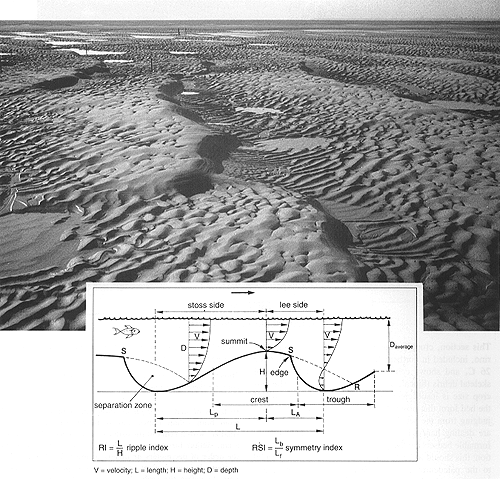
Bed forms: subaqueous dunes and ripples
Plate 28

Bed forms: subaqueous dunes and ripples
Plate 28
The expanse of sand reaching uninterruptedly to the skyline is a view at low tide of a tidal flat, located along the SE coast of the North Sea (Oster Schelde, The Netherlands). At high tide, the same area is completely covered by water. The tidal flat is a depositional surface, where currents produced by tides dissipate their energy and transport sediment. These currents attain maximum velocity during rising or ebbing of the tidal wave, and zero velocity during high and low stands (slack water phase). In some parts of the flat, sand is the dominant sediment; in others, it is mud or an alternation of sand and mud in various proportions.
Bed forms of two scales (dunes and ripples, basically, plus some minor structures) characterize the morphology of this interface. They are produced when a water cover is present (and the current speed is at least 20 cm/s), and are preserved, with some modifications, when it retreats seaward. The implication is that the bedforms still exhibit their equilibrium profiles. Ripples stay on the back of dunes.
Both ripples and dunes are markedly asymmetrical, with a narrow and steep slipface; grain avalanching is the dominant process in subaqueous slipfaces as well as in subaerial ones of eolian forms. The asymmetry of the structures indicates that flood and ebb currents have not the same power, but one is clearly dominant over the other, simulating the effects of a purely unidirectional flow such as a river current. Only some details point to a tidal environment; among them, smoothing of crests by the opposite flow and reactivation surfaces (not visible here but only in section). The partial effacing and flattening of ripples along the dune crests, and some terracing of slipfaces, are effects of water shallowing and emergence, but can also occur in a fluvial bed.
In plan view, the crests of bed forms are highly sinuous with prevalence of concavities facing down current. This is equivalent to attaching, side by side, lunate dunes, the smaller subaqueous correspondent of desert barchans (see plate 30, inset).
The inset summarizes the geometrical parameters in the basic profile of subaqueous bed forms. Velocity vectors (arrows) are enveloped by vertical velocity profiles, whose gradient is related to friction with the bottom. The flow region influenced by bottom or side friction (i.e., close to a solid boundary, generally speaking) is called boundary layer. The flow lines in proximity of the boundary are skin friction lines.
| Photo: G. G. Ori 1992. |